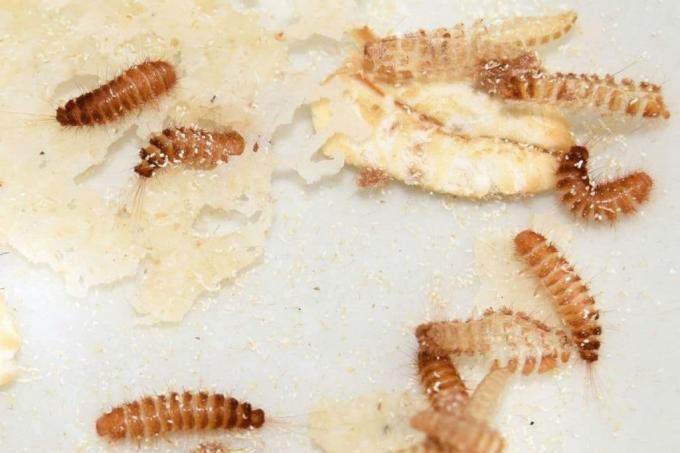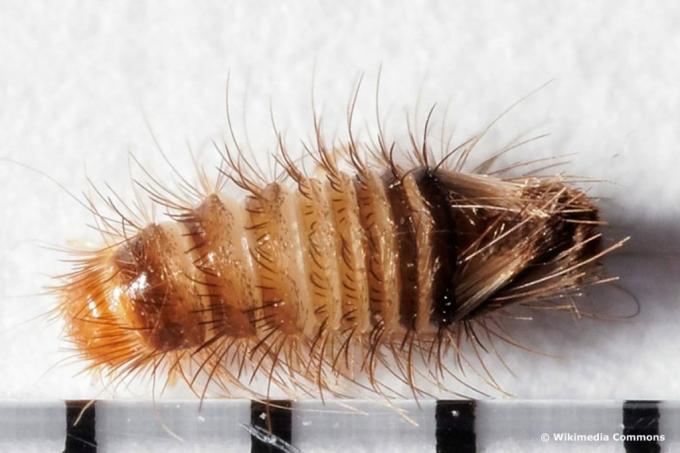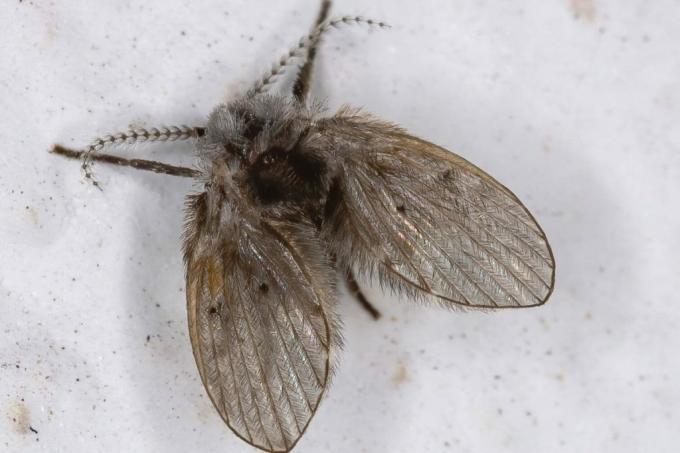
table of contents
- Worms in the bathroom: causes
- Colored beetles
- Fur beetle
- Bacon beetle
- Butterfly mosquitoes
- frequently asked Questions
Insects can often be found in the bathroom. Black and red worms in particular often feel at home there. In order to get rid of them, you first have to recognize them. How to identify and fight worms in the bathroom.
In a nutshell
- are usually not worms, but larvae
- Moisture can attract them, but it doesn't have to be
- the bathroom often also provides a source of food
- Regular thorough cleaning as well as the use of household remedies (e.g. B. Vinegar) promise a remedy
Worms in the bathroom: causes
Regardless of the type of red and black worms in the bathroom, in very few cases it is a hygienic cause. However, the majority of people see these contemporaries as a hygienic problem that they can also pose.
Mainly these are larvae offspring, mostly from beetles, flies or Butterfly species was placed in the bathroom if this offers optimal conditions. In the bathroom, this can be moisture, food sources such as dander and hair, but also certain materials. This mainly includes wood and textiles.
Colored beetles
The beetle (Cleridae) does not directly prefer damp rooms, but it primarily attracts mold, which forms where moisture occurs. He prefers to be protected behind wooden paneling when it absorbs moisture from bathing / showering. This is where it also lays its eggs, from which red worms develop.
Recognize

- Size of the larvae: up to about five millimeters
- Color: white to reddish in color
- Head: black
- Body shape: elongated, cylindrical to slightly flattened body cross-section
- bald or densely hairy rump (partly tomentose)
Fight
Since it is not a pest, control is not absolutely necessary. On the contrary, colored beetles are farm animals because they eat other pests, such as bark beetles. It is therefore advisable to simply collect the larvae and release them alive in nature.
Fur beetle
The fur beetle (Attagenus pellio) usually comes through open windows and doors into the living area as well as into the bathroom if there are food sources for the offspring. The beetle itself is not the problem, but its larvae, because they eat their way through various types of textile. A larva will eat cotton bathroom rugs and towels completely bald if it is not stopped. If dirty laundry is collected in the bathroom, the path also leads there. Dander and hair also serve as food. Otherwise, however, they are often active in wardrobes. If they are red or reddish-looking worms, they are the larvae of the spotted fur beetle.
Recognize

- Larvae size: between eight and ten millimeters long
- Color: first golden yellow, older larvae become increasingly reddish, shiny surface
- Head: widest part of the body
- Body shape: elongated, worm-like
- long, light brown hair arranged like a brush on the end of the body
- short hairs spread over the body (poisonous)
Fight
Fur beetle red worms are pests that should be controlled as follows:
- Remove hair and dander from sanitary facilities
- Thoroughly vacuum the bathroom and ideally vacuum up larvae
- Wipe each area with a 1: 4 ratio of vinegar essence and water (don't like the smell)
- Process non-washable textiles with a steam cleaner
- Wash washable textiles at at least 60 degrees - otherwise dry cleaning
- Remove dirty laundry from the bathroom
- Repeat meticulous basic cleaning every two days
- after seven to ten days everyone should be gone
- alternatively: use biocide-free agents (more environmentally friendly than chemical insecticides)
Bacon beetle
When it gets dark outside and the light is on in the bathroom with the window open, the bacon beetles (Dermestidae) move in. Sometimes they get into the bathroom with the clothes. If there is hair, skin flakes or natural fibers as a source of food for their larvae and it is also nice and warm there, they lay their eggs in a dark place. The larvae also like to hide there later. They are often found under drawer bottoms and cupboards.
Recognize

Source: Arnoldius, Anthrenus scrophulariae (larva), Edited by Plantopedia, CC BY-SA 4.0
- Larvae size: up to 10 millimeters
- Color: reddish brown to black
- Body shape: compact, rounded-oval
- tuft-like bristle hairs on the back
Combat
To get rid of the worm-like larvae from the bath, the same thing helps as described under “Fur beetles”.
Tip: If you discover reddish-brown / red worms in the bathroom, avoid skin contact. If it is the larvae of the bacon beetle, the arrow hairs can cause an allergic reaction on contact. The same goes for their excrement.
Butterfly mosquitoes
The larvae of butterfly mosquitoes (Psychodidae) like to stay in sewage or in its vicinity. This is why black worms are often found in bathrooms. There they crawl out of the drainpipes of showers and sinks and climb out of toilets.
Recognize

- Larvae size: between four and ten millimeters long
- Color: dark brown to black worms, dark rump
- Head: clearly visible head capsule with small antennae
- Body shape: elongated, worm-like, widening towards the rear
- diurnal black worms
- lateral bristle hair
Fight
These larvae are very persistent. In order to get rid of them, many of those affected choose a pest controller. Nevertheless, it is worth trying to deprive them of their nutrient substrate, which is present as a gelatinous film in the sewer pipes. To do this, use a pipe brush that is inserted into the affected pipe several times a day for at least a week. The use of common household cleaners increases the desired effect of the food dissolution.
Tip: Regular cleaning of drain pipes at short intervals is the best way to prevent unwanted insects / pests from "entering". The removal of hair and soap residue should always be combined with the use of household remedies for pipe cleaning.
frequently asked Questions
No, because the larvae of silverfish are initially whitish and then become increasingly greyish and silver-colored like the adults.
In theory yes, but if they are chemical insecticides, they should not be used. These agents are harmful to health and extremely harmful to the environment.
After vacuuming, the filter must be emptied into a garbage bag, tightly closed and disposed of with household waste. If you have a vacuum cleaner bag, this should also be put in a lockable garbage bag. If you do not do this immediately after sucking up, the larvae will crawl out again.



